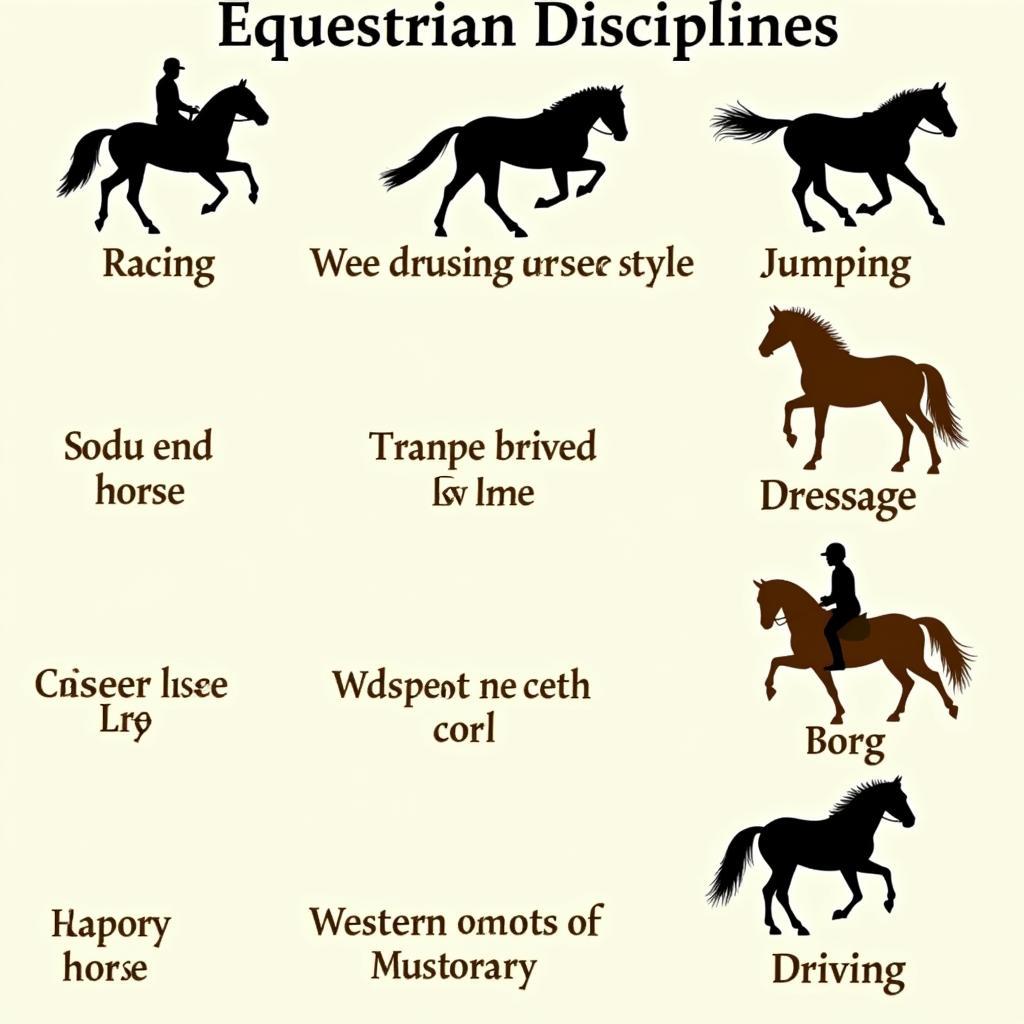Horse Frames are the skeletal structure that dictates a horse’s overall build and plays a crucial role in its movement, performance, and overall health. Understanding different horse frames is essential for anyone involved in equine activities, whether you’re a seasoned equestrian or a casual admirer.
Different Horse Frames and Their Characteristics
Horses are generally categorized into three main frame types: light, medium, and heavy. These classifications are based on the horse’s bone structure, musculature, and overall build. Each frame type possesses distinct characteristics that influence the horse’s suitability for various disciplines. Let’s delve into each type:
-
Light Horse Frame: Light framed horses are characterized by slender bones, refined features, and a generally leaner build. They are often agile and quick, making them well-suited for disciplines such as racing, jumping, and eventing. Think of the sleek Thoroughbred or the agile Arabian.
-
Medium Horse Frame: Representing a balance between strength and agility, medium-framed horses possess a more substantial bone structure than light-framed horses, but not as heavy as draft breeds. They are versatile and adaptable, excelling in a wide range of disciplines, from pleasure riding to competitive showing. The Quarter Horse and the Warmblood are prime examples of this frame type.
-
Heavy Horse Frame: Built for power and strength, heavy-framed horses are characterized by thick bones, heavy musculature, and a larger overall size. These horses are traditionally used for drafting and heavy work, showcasing their immense strength and steady temperament. Breeds such as the Clydesdale and the Shire fall into this category.
How Horse Frames Affect Movement and Performance
A horse’s frame significantly impacts its movement and performance. Light-framed horses are often known for their graceful, flowing gaits and athleticism. Medium-framed horses possess a combination of strength and agility, allowing for versatility in different disciplines. Heavy-framed horses, while not known for speed, possess immense power and stamina, making them ideal for heavy work.
Understanding the relationship between frame type and movement is crucial for selecting the right horse for a specific discipline. For instance, a light-framed horse might excel in show jumping, while a heavy-framed horse would be better suited for pulling heavy loads. condylar fracture horse can occur in any frame type, but understanding the specific stresses placed on each frame can help with prevention and recovery.
Assessing a Horse’s Frame
Evaluating a horse’s frame involves observing its overall build, bone structure, and musculature. You can assess the depth of the chest, the width of the back, and the length of the legs to get a general idea of the horse’s frame type. However, it’s important to remember that there can be variations within each frame type, and some horses may exhibit characteristics of multiple frames.
“Understanding a horse’s frame is like understanding the foundation of a house,” explains Dr. Amelia Hart, Equine Veterinarian. “A strong, well-balanced frame is essential for a horse’s long-term health and soundness.”
Choosing the Right Horse Frame for Your Needs
Selecting the right horse frame depends on your specific riding goals and discipline. If you’re interested in fast-paced sports like barrel racing or jumping, a light-framed horse might be a good choice. If you prefer leisurely trail rides or western pleasure, a medium-framed horse might be a better fit. And if you’re looking for a horse for heavy work or driving, a heavy-framed horse would be the most suitable. Consider horses blue roan as an example; their frame type can influence their suitability for certain disciplines.
 Matching Horse Frames to Disciplines
Matching Horse Frames to Disciplines
Conclusion
Understanding horse frames is paramount for anyone involved in the equine world. By recognizing the characteristics of different frame types and their impact on movement and performance, you can make informed decisions about choosing the right horse for your needs and ensuring its long-term health and well-being. Whether you admire the powerful build of a draft horse or the sleek elegance of a Thoroughbred, appreciating the diversity of horse frames adds to the richness of the equine experience. Remember that choosing the right tack, like the horse trailer window parts, is crucial for any horse, regardless of frame. You can even find beautiful framed horse prints to celebrate your favorite frame types! You might also be interested in the iron horse dh bike, a completely different kind of “horsepower”!
FAQ
- What are the three main horse frame types?
- How does a horse’s frame affect its movement?
- What factors should I consider when choosing a horse frame for a specific discipline?
- How can I assess a horse’s frame?
- What are some examples of breeds for each frame type?
- Can a horse’s frame change over time?
- How does nutrition impact a horse’s frame development?
For further assistance, contact us at Phone Number: 0772127271, Email: [email protected] or visit us at QGM2+WX2, Vị Trung, Vị Thuỷ, Hậu Giang, Việt Nam. We have a 24/7 customer support team.